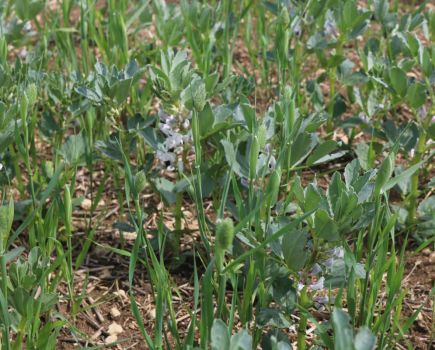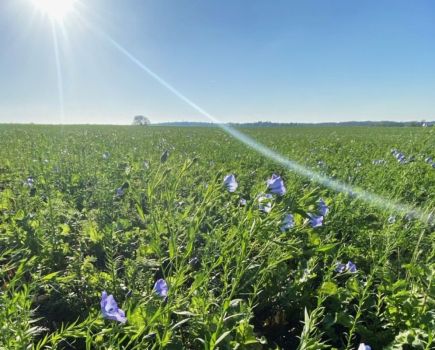A PhD study conducted using Agrovista’s Lamport AgX site is providing a scientific basis for why cover crops help to improve soil health. CPM heard more at the recent BASE-UK conference.
“What we want to create is a system that stores more than what leaves, and at the moment, most production systems do the opposite.”
By Mike Abram
Agrovista’s Lamport AgX (formerly Project Lamport) might be best known for its blackgrass research, but during the past six years it’s also investigated improving soil health and function.
A key driving force for that work is a perhaps unlikely source in David Purdy. A territory business manager in East Anglia for John Deere, he also has a passion for soils which led him to undertake a PhD at Nottingham University investigating soil and plant interactions.
Lamport AgX is an important site for his research. Together with various partners, he’s investigated cover and companion crops, varying depths and levels of soil disturbance, compaction, different cropping and rotations, and establishment methods, including drill type, residue management and dates.
Located in Northamptonshire on a degraded silty clay loam soil by virtue of its 1:13 soil organic carbon to clay ratio, the fundamental challenge David is trying to address is getting energy into the soil, because he says this is what helps it to function.
Functioning soils produce good cash and cover crops, cycle and manage water effectively, be resilient in both wet and dry seasons, cycle and store carbon and nutrients and be supportive and resilient to machinery, he explains.
“Another key function is effective gaseous exchange – I’m thinking particularly about oxygen and air, but also carbon dioxide and ethylene have to leave the soil,” explains David.
Ethylene is a major plant hormone released from roots, he says. “If you don’t allow it to move away from the roots, it backs up and the plant stops growing. Compaction isn’t about mechanical constriction as much the build-up of ethylene.”
A healthy functioning soil results from getting energy in the form of carbon into the system, he says. “That’s about having plants living in the soil, with cover and catch crops providing an important route to maximising the length of time plants are living in the soil year-round.”
Achieving that helps to overcome three of the major challenges to soil function – the loss of organic matter, soil compaction at depth and surface, and soil erosion. “To deal with those effects we’ve tried to build production systems at Lamport that sequester and store carbon in the soil,” he says.
In biological terms, carbon is delivered into soils through photosynthesis as exudates which leak out from plants, especially roots, and feed soil microbes. That’s the process of sequestration – how carbon gets into the soil – but it doesn’t necessarily equate to storage because carbon will also leave through microbial respiration. If more carbon is leaving than coming in, that’s energy leaving the system.
“What we want to create is a system that stores more than what leaves, and at the moment, most production systems do the opposite.”
Carbon flux readings, such as those carried out at Riseholme Farm by the University of Lincoln and Centre for Ecology and Hydrology, also highlight it’s a dynamic system depending on management.
The readings taken during an 18-month period when sugar beet and spring barley crops were grown showed that during those crops’ lifetimes, there were some periods where carbon was being sequestered into soils, but also particularly around establishment and harvest, and in between crops, more carbon was released from the field.
“Cash crops are critically important to this carbon story, but there are times in between when you perhaps have the opportunity to grow cover or catch crops to get carbon into our soils.”
Combining that with reduced tillage intensity should increase net sequestration, ultimately leading to storage in our soils, he explains.
One of the long-term trials carried out at Lamport AgX is an eight-treatment trial comparing three cover crop mixes with plots grown without cover crops, with each option established using tillage, typically annual subsoiling to a depth of 25cm regardless of requirement, or no tillage.
“When we started this trial in 2018/19 we had low earthworm counts of around 180/m3 – approximately four per spade. We’re now getting upwards of 22 per spade – around 600/m3 where we’ve grown the cover crops.”
The increase in earthworms is driven by cover crop biomass with a clear correlation between higher peak biomass measured by NDVI within the cover crop plots and higher earthworm numbers, he explains.
Increased earthworm abundance drives nutrient cycling and therefore yield, according to recent research studies published in Nature. “The paper suggests earthworms make around a 6.5% contribution to global grain yields, rising to 8% in Europe; it’s all about nutrient cycling.”
At Lamport, David’s research has concentrated on infiltration rates which is another fundamental function earthworms deliver. Perhaps surprisingly, in the trial, where earthworm abundance with cover crops increased in year two, improved water infiltration rates took longer to demonstrate.
“It was only in year three when we started to see infiltration rates increase and from year four onwards we could see the soils handle water much better. We can see a huge difference in soil structure from year one to now.”
The combination of different biology in soils from earthworms to bacteria and fungi, in simple terms, move soils, sew it together, glue and eat it, which helps to create soil structure, says David.
“What biology does, which nothing else does in soil, is create space in soils on a wide range of spatial scales – so you have big pores and lots of little pores. The big pores when it’s very wet allow water to drain quickly, but the little pores when the soil is very dry hold onto moisture.”
He says the combination of the two is crucial to moisture management, as is the connection between those spaces.
At Lamport, differences in soil structure between plots managed in different ways is stark after five years (see picture). Plots receiving the 25cm deep tillage operation without any cover crop are getting worse each season, says David. “If I picked up one of those big lumps and throw it on the ground it wouldn’t shatter.”
In comparison, the neighbouring plot has also never had any cover crops, but also no tillage. “It started looking really ugly,” comments David. “But at the end of year three the soil started to break down. I wouldn’t call it aggregated, but if you leave soils alone, they do a good job recovering.”
A third plot has cover crops and tillage. “The cover crops are having some benefit at the top, but they haven’t reached lower down. What we’ve lost in this soil is porosity.”
In contrast, the plot with multi-species cover crops and no tillage had both a darker colour and better soil structure. “It’s difficult soil at Lamport, but this now just crumbles in your hand.”
By way of comparison, soil structure from the field margin was an even darker colour and better aggregated. “So we’ve seen a huge change to soils – cover crops accelerate the changes, bringing aggregation and the spatial pore spacing and porosity.”
But establishment and termination date are crucial to getting the best results he says, with species less important. His advice is to avoid planting and terminating late.
This is because there’s a significant drop off in dry matter from establishing cover crops even from mid-August to late-August, while some species, such as clovers, struggled to establish at all from a mid-September drilling date, he notes.
“Once you get into September, the day length is shutting down and you don’t get the biomass from cover crops.” And according to the Lamport trials, leaving cover crops to grow for longer in the spring results in significant yield penalties. “Our work suggests early termination is best – by mid-January.”
That could contradict Sustainable Farming Incentive scheme guidance for cover crop termination, he raises. “We like to have eight weeks between termination and planting, while SFI suggests six weeks, so it’s a challenging decision.”
But what has been the impact of using cover crops on carbon stocks in the soil, and how does that compare with using tillage? To answer, David measures soil organic matter and converts it to soil organic carbon, multiplies by depth of soil profile and bulk density at the same depth.
“At Lamport there’s been no change in the top 15cm where cover crops are being grown, but carbon is increasing in the 15-30cm layer, storing 44t/ha compared with 36t/ha of carbon where cover crops haven’t being grown. We’ve actually drawn down 27t CO2e into that layer,” explains David.
In comparison, tillage has released 17t/ha CO2e into the atmosphere compared with no tillage in the 0-15cm subsection.
Those findings help to explain a key practical challenge highlighted by the Lamport trials – how cover crops contribute to very shallow compaction to around 80mm depth, and the effect on following crop establishment.
By measuring soil bulk density at different depths, David has shown that growing cover crops reduces bulk density to the same level as subsoiled plots at 15-30cm depths, but critically not at the soil surface. That’s because the carbon has been built at depth and the two things are linked, he explains.
“But the cover crops aren’t delivering the construction we want at the surface, so in our no-till systems when we get a very dry period in the spring, we have half the plant counts, regardless of growing cover crops, that we get out of our tillage system.”
It only happens when soils dry and is partly related to how hard the soil is, with the compaction not necessarily visible at planting.
Further investigations by David suggest a relationship to soil packing density which is the density of soil particles not including pore spacing, in comparison to bulk density which is the density of a volume of soil as it occurs naturally. It’s calculated from bulk density using a weighting based on the amount of clay and silt in the sample.
“What I found is only a very small change in packing density is required to double plant counts. That means we don’t have to pulverise soils, but just gently stretch them to counteract the surface compaction.”
While David says he hasn’t found the perfect machine, trials using a low disturbance grassland subsoiler with legs 450mm apart dropped in as shallow as possible to about 12cm, has worked well. He’s hopeful that type of option will still qualify for no-till SFI payments in the future.
Carbon stock measurements can also be used to help calculate soil organic carbon to clay ratio to compare to the 1:10 benchmark Rothamsted research suggests is a good soil quality, with 1:13 being a degraded soil.
Comparing plots after five years suggests, despite the improvements cover crops and no-till have made to soil quality, there’s still a way to go to reach the field margin benchmark at Lamport.
Using cover crops has improved the SOC:clay ratio to 1:16 from 1:19.3 at 15-30cm depth, which is still someway short of the 1:8 ratio of the field margin, notes David. Tillage has further degraded the top 15cm from 1:9.7 to 1:10.4.
And don’t expect cover crops to improve yields, he warns. After 11 replicated trial harvests across five years with various tillage treatments, not one has shown a significant yield improvement. “The chances are cover crops aren’t going to improve yields, but you’ll improve the function of your soils, which is really important.
“It will drive biology, improving soil structure; it’s probably going to increase carbon storage, improve water management in soils, and reduce erosion. Growing cover crops should reduce the requirement for intensive tillage, while not eliminating it, should improve trafficability and overall sustainability and resilience.
“And there’s a lot of opportunity, especially with SFI options, whether autumn or summer cover crops, or leaving a poor part of a field in a 12-month cover crop to get energy into the soil and bring a huge amount of function into it,” he concludes.
This article was taken from the latest issue of CPM. For more articles like this, subscribe here.
Sign up for Crop Production Magazine’s FREE e-newsletter here.




